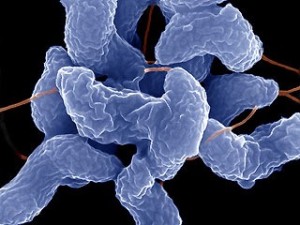Clinical isolates of Campylobacter spp. and Salmonella spp. are notifiable in Switzerland. In 1995, Campylobacter replaced Salmonella as the most frequently reported foodborne pathogen. We analysed notification data (1988–2013) for these two bacterial, gastrointestinal pathogens of public health importance in Switzerland.
 Notification rates were calculated using data for the average resident population. Between 1988 and 2013, notified campylobacteriosis cases doubled from 3,127 to 7,499, while Salmonella case notifications decreased, from 4,291 to 1,267. Case notifications for both pathogens peaked during summer months. Campylobacter infections showed a distinct winter peak, particularly in the 2011/12, 2012/13 and 2013/14 winter seasons. Campylobacter case notifications showed more frequent infection in males than females in all but 20–24 year-olds. Among reported cases, patients’ average age increased for campylobacteriosis but not for salmonellosis.
Notification rates were calculated using data for the average resident population. Between 1988 and 2013, notified campylobacteriosis cases doubled from 3,127 to 7,499, while Salmonella case notifications decreased, from 4,291 to 1,267. Case notifications for both pathogens peaked during summer months. Campylobacter infections showed a distinct winter peak, particularly in the 2011/12, 2012/13 and 2013/14 winter seasons. Campylobacter case notifications showed more frequent infection in males than females in all but 20–24 year-olds. Among reported cases, patients’ average age increased for campylobacteriosis but not for salmonellosis.
The inverse trends observed in case notifications for the two pathogens indicate an increase in campylobacteriosis cases. It appears unlikely that changes in patients’ health-seeking or physicians’ testing behaviour would affect Campylobacter and Salmonella case notifications differently. The implementation of legal microbiological criteria for foodstuff was likely an effective means of controlling human salmonellosis. Such criteria should be decreed for Campylobacter, creating incentives for producers to lower Campylobacter prevalence in poultry.
Inverse trends of Campylobacter and Salmonella in Swiss surveillance data, 1988–2013
Eurosurveillance, Volume 21, Issue 6, 11 February 2016
C Schmutz, D Mäusezahl, M Jost, A Baumgartner, M Mäusezahl-Feuz
http://www.eurosurveillance.org/ViewArticle.aspx?ArticleId=21375
